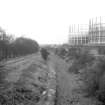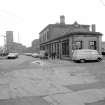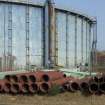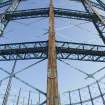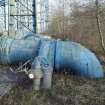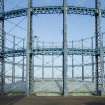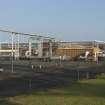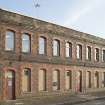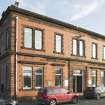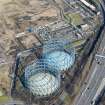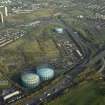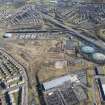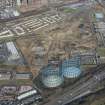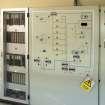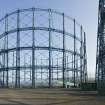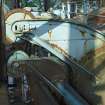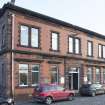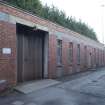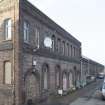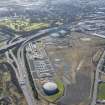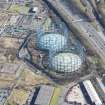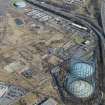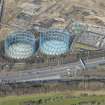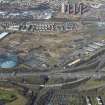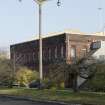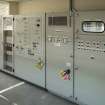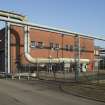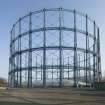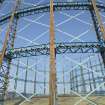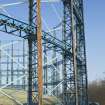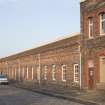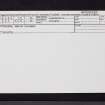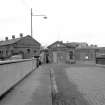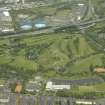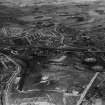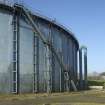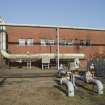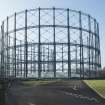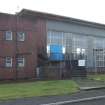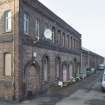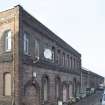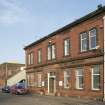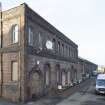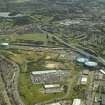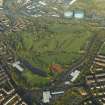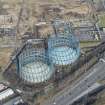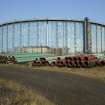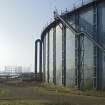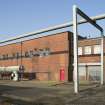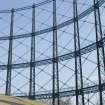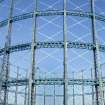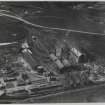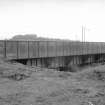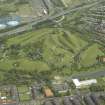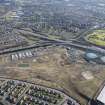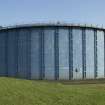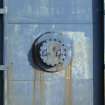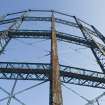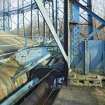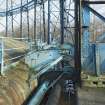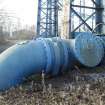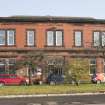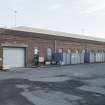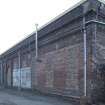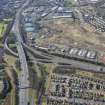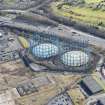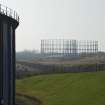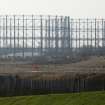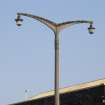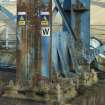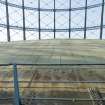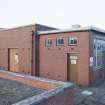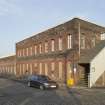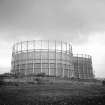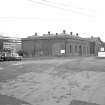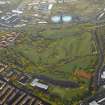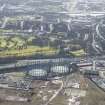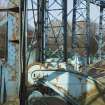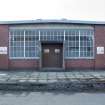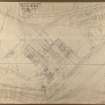Glasgow, Provan Road, Provan Gasworks
Gas Works (19th Century) - (20th Century)
Site Name Glasgow, Provan Road, Provan Gasworks
Classification Gas Works (19th Century) - (20th Century)
Alternative Name(s) Provan Gas Works; Provanmill
Canmore ID 45018
Site Number NS66NW 30
NGR NS 62250 66600
NGR Description Centred NS 62250 66600
Datum OSGB36 - NGR
Permalink http://canmore.org.uk/site/45018
- Council Glasgow, City Of
- Parish Glasgow (City Of Glasgow)
- Former Region Strathclyde
- Former District City Of Glasgow
- Former County Lanarkshire
NS66NW 30.00 centred 62250 66600
Location formerly cited as NS 621 666.
NS66NW 30.01 NS 62020 66265 Gasholder
NS66NW 30.02 NS 62115 66310 Gasholder
For (adjacent) Provanmill Chemical Works (centred NS 623 669), see NS66NW 459.
For barrage balloon site (NS c. 6201 6648) within the area of the gasworks, see NS66NW 385.
Provan Gas Works, Provan Road, built 1900-4 for Glasgow Corporation Gas Dept, William Foulis, engineer, and greatly extended after 1919. Dominated by two gasholders, each 280ft [85.4m] in diameter, the main parts of the works are modern, though one- and two-storey red brick stores, offices and workshops survive from earlier phases of development. There is a particularly neat gatehouse with a red sandstone pedimented front.
Vertical retorts were installed before 1914; there is a chemical works at the plant.
J R Hume 1974.
This gasworks is not noted as such on the 1954 and 1960 editions of the relevant OS 1:1250 map sheets. What are evidently gasholders are depicted at NS 62020 66265 and NS 62115 66310 respectively.
Information from RCAHMS (RJCM), 13 December 2005.
NMRS REFERENCE:
'Glasgow Corporation Gas Department' Glasgow, 1949 p.12. Missing at time of upgrade 7.8.2000
Publication Account (1904)
Provan gasworks was built on a 123 acre site aquired by Glasgow Corporation to the east of the city. It was claimed in 1904 that the works when completed could manufacture 48,000,000 cubic feet of gas per day (there were to have been 5 gasholders on site). Town or coal gas was manufactured here. By the late 20th century all of the gas making buildings had been demolished and the gasholders were used for storing natural or north sea gas. Due to the different levels on the site, and this was used to advantage.
The coal, lime and so on required for required in the making of town gas. were broght in at a high level and the spent coal (coke) and other material was sent off site on the low level. The northernmost part of the ite had a residual products works. Here the bye products of gas making - ammoniacal liquor and tar flowed there using gravity as the site sloped down to the north east. At this chemical works sulphate of ammonia, pitch, naptha,benzole and carbolic acid were manufactured. When initially costructed Provan had a 'main avenue'. On one side were the offices and workshops (both of which survive), small locomotive sheds, workmen's bathrooms and dining hall (demolishd). On the other side were the governor, meter, exauster and boiler houses (demolished).
The boiler house contained two Babcock and WIlcox water tube boilers fitted with 'Meldrum' furnaces. Each boiler could evaporate 8000 ounds of water per hour at a 'pressure of 150 pounds per square inch. The two compound pumping engines were by the Airdrie Iron Company and supplied water at 500 pounds per square inch pressure to the charging, drawing and tipping machines and to the hydraulic capstans.
The retort houses were 390 feet 8 inches in length by 78 feet in breadth. Each retort house contained 720 fireclay retorts, built in 'regenerative settings of twelves'. The coal passed from the main storage hoppers to breakers and then to a bucket gravity bucket conveyer, The coal was thus carried to the overhead storage hoppers which in turn supplied the charging machinery for filling the retorts.
The charging (filling) and drawing (emptying) machines were of the 'Arrol-Foulis' type invented and patented by Mr Foulis and Sir William Arrol. These machines reduced the cost of carbonising and made labour efficiencies possible in the retort house. All coal and coke was handled by machinery on site - there was no manual handling at any point. The spent coal or coke when drawn from the retorts fell through the retort house floor into wagons on the narrow gauge railway on the ground floor. The small Andrew Barclay locomotives and conveyed to to the plant for storing, screening and loading the coke.
Some of the coke was not quenched burt removed hot from the retorts and was taken in hopper style wagons to fill the producers. The fuel gas with which the retorts were heated was generated in the large gas producers outside the retort house. The gas was moved to the retort settings along steel mains pipes lined with firebricks.
The hot coke whilst still in its tipping wagons was quenched by a shower of water in the coke quenching houses. It was then discharged into one of the theree steel hoppers which fed the buckets of the coke conveyors. It was then moved to the screening machinery wher it was sorted and loaded into railway wagons. The conveyors were also designed to store the coke as it could be discharged along its length to create a coke heap 140 feet in length and 50 feet in height.Travelling cranes could then remove coke from stock as required.
Oil Gas Plant: this plant had four units, each capable of producing 2500 cubic feet of gsa per hour. This was housed in a steel framed structure coverd with corrugated sheeting as it was required to be of a temporary nature.
The purifier house: This was 503 feet in length and 85 feet in width and contained 24 purifiers in six sets of four. This part of the plant was made and erected by the Branson Bridge Building Company. The purifying agent was lime which was fed into the purifiers from above through camvas chutes.
The spent lime was discharged through plugs in the bottom of the purifiers into the narrow gauge railway beneath. The lime that was required for purification of the coal gas was burnt in lime kilns within the works asthere was a plentiful supply of limestone.
The scrubbers and water tube condensers: The 'Holmes' rotary scrubbers were a portion of the cyanide plant. This allowed the cyanogen to be extraced from the gas. Four ammoniacal scrubbers, 'Walker's' purifying machines, had been built by 1904. These abstracted ammonia from upto 3,000,000 cubic feet of gas every 24 hours. The four water tube condensers (Kirkham, Hulet and Chandler) were situated between the scrubbers and the exhauster house. Each condenser could deal with 3,000,000 cubic feet of gas every 24 hours.
The exhauster house contained eight 'Waller's' patent exhausters in four sets of two, each set driven by a vertical steam engine. Each exhauster could pass 120,000 cubic feet of gas per hour if required. By 1904 three gas maters for measuring the gas produced had been erected. Each meter was capable of passing 200,000 cubic feet of gas per hour. Space had been laid aside for another three meters.
The gasholders 'are being made' by the Barrowfieeld Iron Works limited according to the author of the pamphlet/. One had been finishd by 1904 and in use, the second holder was under construction by the official opening of the site in September 1904. Both holders were of the same diemnsions with the uter lift 280 feet in diameter and 50 feet in depth. The middle lift was 276 feet and 10inches in diameter by 50 feet in depth. The innr lift was noted as being 273 feet 9 inches in diameter by 51 feet in depth, each holder having the capacity of 8,500,000 cubic feet of gas. the tanks were but by Messrs Robert MacAlpine and Sons (contarctors for all of the buildings on site unless otherwise stated) ar of brick, the depth from the copeto rhe granite bearing blocks be8ing 50 feet in depth. The guide framing standards erected by Sir William Arrol and Co. Ltd were 152 feet 6 inches in height.
There was also a pump house supplying water to the works close to the holders/. The plant, consisted of two sets of centrifyugal series pumps, driven by 'Acme' gas engines which delivered water to a high level reservoir. This plant was needed as the pressure form the water mains was insufficient to supply higher parts of the works.
The govrnor house contained a 'Parson's' turo-exhaustr. this propleeled the gas doen the high perssure main to the holders at Dalmarnock. This plant could deal with upto 780,000 cubic feet of gas per hour and was 'guaranteed tp pump the full quantity with a difference of pressure between the inlet and outlet of 24 inches of water'.
Three bridges had to be built with the consstruction of a new road along the eastern boudary of Alexandra Park.. One crossed the Monkland Canal and two crossing the Caledonian Railway.
Cororation of Glasgow, Gas Department, 1904; see HES drawing number GWD/177/1
Publication Account (1949)
In 1921 an installation of eight benches of vertical retorts was completed. The rated capacity was 18 million cubic feet per day, and the plant was at that time the largest installation in the world to be housed within one building. From 1940 to 1943 the retort portions of the benches [original 1903/1904 horizontal retorts] were rebuilt.
Two carburretted [blends air and fuel in internal combustion engine] gas units of a total capacity of 5 million cubic feet per day were put into operation in 1940 and a third stand by unit of 2.5 million cubic feet per day capacity was completed in 1943.
There are two gasholders having a total capacity of 16 million cubic feet.
The area of the works is approximately 123 acres. The total number of employees at these works is 524.
Coke Oven Gas: A supply of coke oven gas averaging 2.5 million cubic feet per day has been taken in at Provan Gasworks since May 1943 from the Gartsherrie Ironworks of Messrs Bairds and Scottish Steel Ltd.
Provan Gasworks supplied the north eastrn part of the sity in 1949 from area north to Bishopriggs, east to Gartcosh, and Easterhouse
Glasgow Corporation Gas Department, 1949
Publication Account (1998)
As with all large town gasworks of the time, Provan had its own internal railway to serve its sidings from the main railway line which brought in coal, lime etc. and sent out coke (burnt coal). It had seven and a half miles of standard gauge and one and a quarter miles of narrow gauge. This would have increased as the site expanded. Andrew Barclay of Kilmarnock supplied six narrow gauge locomotives in 1903 (scrapped by late 1950s). A second batch was purchased in 1916.
Provan was nationalised in 1949 and narrow gauge working ceased in 1959. Two of the narrow gauge Andrew Barclay locomotives were preserved.
A Booth, 1996
Note (4 May 2017)
Provan gasworks is named and depicted on the Ordnance Survey, 25-inch map (Lanarkshire, 1912 (revised 1910), sheet 6.08). Built for Glasgow Corporation 1900-1904. The surviving structures from the original construction phase are No.1 and No.2 gasholders (now decommisioned) as well as the workshops and offices which are still in use by Scottish Gas Networks (leased from another company).
See drawing GWD/177/1.
Information from Survey and Recording Section, Heritage Directorate, HES (MMD), 4th May 2017.



























































































